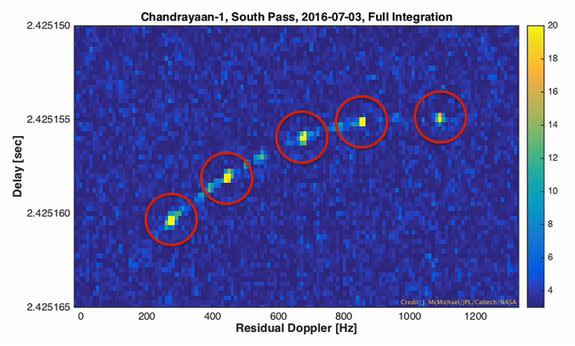How NASA found India's long-missing moon probe

NASA just found a long-lost spacecraft orbiting the moon.
The Indian Space Research Organization's (ISRO) Chandrayaan-1 probe was lost less than one year after its 2008 launch, but now, thanks to help from the U.S. space agency, it has been found again.
SEE ALSO: India is launching its second moon mission early next year
The spacecraft — India's first moon probe — was found along with NASA's Lunar Reconnaissance Orbiter (LRO) circling the moon.
"Finding LRO was relatively easy, as we were working with the mission's navigators and had precise orbit data where it was located. Finding India's Chandrayaan-1 required a bit more detective work because the last contact with the spacecraft was in August of 2009," Marina Brozovic, a radar scientist working on the project, said in a statement.

Image: NASA
The Chandrayaan-1 project, which cost the country north of $50 million, was years in the making, and naturally, a lot was expected of it.
The spacecraft came equipped with high-resolution remote sensing equipment for surveying the lunar surface and mapping the moon's chemical characteristics.
In August 2009, ISRO said it lost contact with Chandrayaan-1, meaning that the space agency couldn’t receive any images from the spacecraft, nor could it assume control over it.
The space agency had officially lost all hope for reconnecting with the probe, even though it was still in orbit around the moon. “The mission is definitely over,” Project Director of the Chandrayaan-1 mission M Annadurai was quoted as saying.

Image: NASA/JPL-Caltech
Now, eight years after it went silent, the Chandrayaan-1 probe has been found.
The NASA team that found the probe says it knew the Chandrayaan-1 was still orbiting so they started looking at places where the thought the spacecraft would be at specific times. Last year, the team spotted "a radar signature of a small spacecraft" which matched Chandrayaan-1’s profile.
After doing more analysis, the team figured out exactly where to find the Chandrayaan-1.
"It turns out that we needed to shift the location of Chandrayaan-1 by about 180 degrees, or half a cycle from the old orbital estimates from 2009," NASA's Ryan Park said in the statement. "But otherwise, Chandrayaan-1's orbit still had the shape and alignment that we expected."
"Radar echoes from the spacecraft were obtained seven more times over three months and are in perfect agreement with the new orbital predictions," the team wrote.
